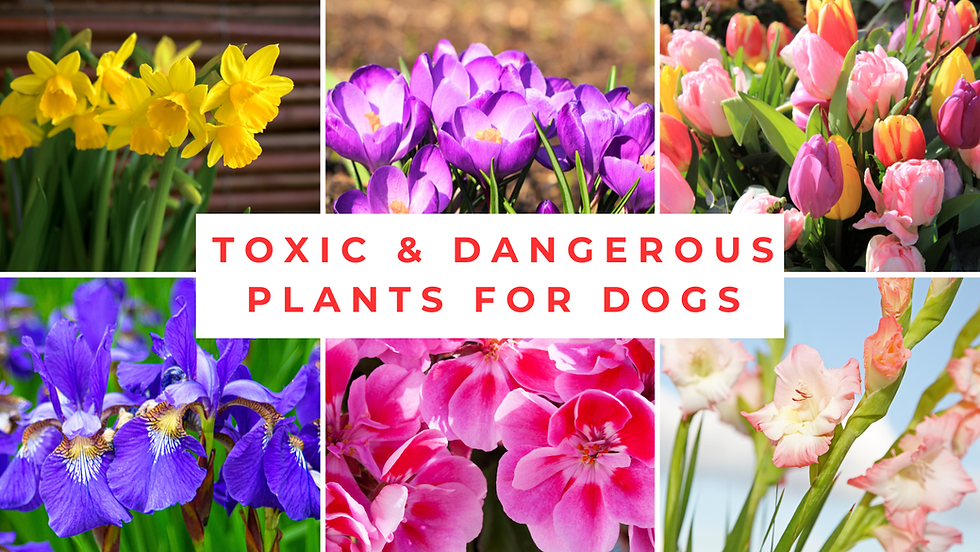DANGER - Toxic Plants, Trees and Shrubs for your New Puppy
- Natasha Green
- Apr 3, 2024
- 3 min read
Pets like to explore and may try to eat plants and trees. Some plants can make them sick or even be dangerous. It's important to know which plants could be a problem.
Some plants are safe for pets, but others can make them sick or even be harmful. It's best to avoid poisonous plants altogether.
Certain parts of plants, like leaves or flowers, can be more dangerous than others. Seeds, bulbs, and berries are often more toxic. Pets can even dig up bulbs and seeds!
Different plants grow at different times of the year, so it's important to know what's risky each season. There are many types of plants, so it's hard to list them all. We've put together a list of common poisonous plants.
If you think your pet ate something bad, call your vet right away, even if you're not sure what they ate.
Sometimes you can see your pet eating a bad plant, but other times you might not know until they start showing signs of being sick.
These signs can include:
Being tired
Throwing up
Having diarrhoea
Blood in their poop
Drinking or peeing a lot
Pale gums
Twitching
Shaking
Trouble breathing
Falling down
Drooling
Not eating
Some plants can also irritate the skin or mouth, causing rashes or swelling.
To keep your pet safe, watch them outside and only have safe plants in your garden. If you're not sure what's wrong with your pet, call your vet immediately.
Certain plants pose significant risks to pets due to their toxicity. While many plants may cause mild gastrointestinal issues, others can lead to severe symptoms or even be life-threatening.

Here's a list of some particularly dangerous plants:
Autumn Crocus
Azalea/Rhododendron
Cotoneaster
Cordyline/Dracaena
Daffodil
Dumbcane
Horse Chestnut
Oak
Peace Lilies
Potato plants
Yew
Among these, certain plants stand out for their high toxicity:
Mushrooms/Fungi: While not all fungi are toxic, some species can cause serious gastrointestinal issues, seizures, or organ failure. Due to the difficulty in identifying toxic varieties, it's safest to prevent pets from consuming any mushrooms.
Giant Hogweed (Heracleum mantegazzianum): This plant poses risks to both pets and humans, causing skin burns and blisters upon contact due to its toxic sap. Veterinary assistance should be sought if a pet encounters Giant Hogweed.
Spring is synonymous with blooming flowers and the planting of bulbs, yet it's crucial to recognise that bulbs can harbour a higher concentration of toxins compared to leaves or flowers. Ensuring your garden is safe for your pets involves thoughtful organisation and prevention.
It's essential to keep bulbs out of your pet's reach or avoid planting them altogether, as various bulb species can be poisonous. If you do opt to plant bulbs, consider covering them with mesh until they've sprouted to deter curious paws from digging them up.
Plants to steer clear of include:
Azalea/Rhododendron (Rhododendron species)
Crocuses (Crocus Sp)
Daffodil (Narcissus species)
Cotoneaster (Cotoneaster species)
Giant Hogweed (Heracleum mantegazzianum)
Geranium (Pelargonium species)
Heavenly bamboo (Nandina domestica)
Holly (Ilex species)
Horse chestnut (Aesculus hippocastanum)
Hyacinth (Hyacinthus orientalis)
Iris and gladioli (Iridaceae)
Ivy (Hedera)
Laburnum (Cytisus alpinus)
Laurel including Cherry Laurel (Prunus laurocerasus) and other laurels
Mistletoe (Viscum album)
Oak (Quercus pedunculata)
Onions and garlic plants (Allium species)
Ragwort (Senecio jacobaea)
Rhubarb (Rheum rhabarbarum)
Rowan (Sorbus aucuparia)
Snowdrops (Galanthus species)
Tulip (Tulipa species)
Yew (Taxus baccata and related species)

Spring is also a time for hedge trimming, so be diligent in clearing up any pruned branches and leaves, as certain hedgerow plants like Cherry Laurel can pose risks to pets.
Identifying and avoiding poisonous plants is crucial to safeguarding our pets' health and well-being. While some plants may only cause mild gastrointestinal discomfort, others can lead to severe toxicity or even fatality. Recognising toxic plants and understanding the symptoms of plant poisoning are essential for prompt intervention, even if the ingestion is not witnessed.
Plant toxicity can manifest differently in individual pets, making it prudent to steer clear of poisonous plants altogether. Certain parts of plants, such as leaves, flowers, seeds, bulbs, and berries, can pose greater risks, with green leaves often being more toxic. Additionally, bulbs and seeds buried underground can still be accessible to curious pets.
Beyond plants, other hazards such as grass seeds, pesticides, weed killers, and compost bins can also pose dangers to pets. Vigilance and proactive measures, including keeping potentially harmful substances out of pets' reach, are essential for ensuring their safety and well-being.
Since various plants thrive during different seasons, it's important to be mindful of the risks each season presents.






